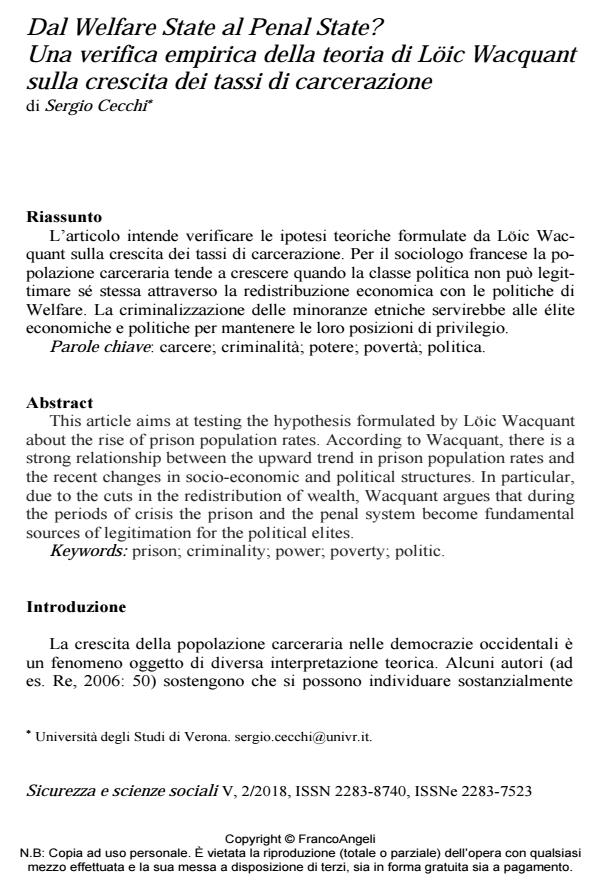Dal Welfare State al Penal State? Una verifica empirica della teoria di Löic Wacquant sulla crescita dei tassi di carcerazione
Journal title SICUREZZA E SCIENZE SOCIALI
Author/s Sergio Cecchi
Publishing Year 2019 Issue 2018/2 Language Italian
Pages 19 P. 72-90 File size 256 KB
DOI 10.3280/SISS2018-002006
DOI is like a bar code for intellectual property: to have more infomation
click here
Below, you can see the article first page
If you want to buy this article in PDF format, you can do it, following the instructions to buy download credits

FrancoAngeli is member of Publishers International Linking Association, Inc (PILA), a not-for-profit association which run the CrossRef service enabling links to and from online scholarly content.
This article aims at testing the hypothesis formulated by Löic Wacquant about the rise of prison population rates. According to Wacquant, there is a strong relationship between the upward trend in prison population rates and the recent changes in socio-economic and political structures. In particular, due to the cuts in the redistribution of wealth, Wacquant argues that during the periods of crisis the prison and the penal system become fundamental sources of legitimation for the political elites.
Keywords: Prison; criminality; power; poverty; politic
- Arvanites T.M., Asher M.A. (1995). The direct and indirect effects of socioeconomic variables on state imprisonment rates. Criminal Justice Policy Review, vol.7: 27-53.
- Barbagli M. (2008). Immigrazione e sicurezza in Italia. Bologna: il Mulino.
- Barbagli M., Gatti U., (a cura di) (2002). La criminalità in Italia. Bologna: il Mulino.
- Beckett K, Western B. (2001). Governing Social Marginality: Welfare, Incarceration, and the Transformation of State Policy. In: Garland D., Mass Imprisonment: Social Causes and Consequences. London: Sage.
- Curi U. (a cura di) (2017). Vergogna ed esclusione. L’Europa di fronte alla sfida dell’emigrazione. Roma: Lit.
- Dal Lago A. (2004). Non-persone. L’esclusione dei migranti in una società globale. Milano: Feltrinelli.
- De Giorgi A. (2010). Immigration control, post-Fordism, and less eligibility. A materialist critique of the criminalization of immigration across Europe. Punishment and Society, vol. 12-2: 147-167.
- Di Nicola P (2014). Social Capital and the Functioning of Welfare Systems. Italian Sociological Review, vol. 4(3): 253-285.
- Elias N. (2009). La civiltà delle buone maniere. La trasformazione dei costumi nel mondo aristocratico occidentale. Bologna: il Mulino.
- Esping Andersen G. (2011). La rivoluzione incompiuta. Donne, famiglie, Welfare. Bologna: il Mulino.
- Eurostat (2017). http://ec.europa.eu/eurostat.
- Ferrera M. (a cura di) (2012), Le politiche sociali. L’Italia in prospettiva comparata. Bologna: il Mulino.
- Fox Piven F. (2010), Neoliberismo e neofunzionalismo. In: Gelardi M. (a cura di), Lo stato penale globale. Milano: il Saggiatore.
- Garland D. (1990). Punishment and Modern Society. Chicago: Chicago University Press (trad it.: Pena e società moderna. Uno studio di teoria sociale. Milano: il Saggiatore).
- Gelardi M. (a cura di) (2010). Lo stato penale globale. Milano: il Saggiatore.
- Granados JAT, Ionides EL. (2010). Mortality and macroeconomic fluctuations in contemporary Sweden. European Journal of Population, vol. 27: 157-84.
- Greenberg, D. (1999). Punishment, Division of Labor, and Social Solidarity. In: Laufer W.S. and Adler F., a cura di, The Criminology of Criminal Law. Advances in Criminological Theory, vol. 8: 283–361. New Brunswick: Transaction Books.
- Greenberg D. F., West V. (2001). State Prison Populations and Their Growth, 1971-1991. Criminology 39:61: 5-54.
- Kazepov Y., Carbone D. (2007). Che cos’è il welfare state. Roma: Carocci.
- Matthews R. (2009). Doing Time: An Introduction to the Sociology of Imprisonment. London: Palgrave Macmillan.
- Melossi D. (2002). Stato, controllo sociale, devianza. Milano: Bruno Mondadori.
- OECD (2017). Organisation for Economic Co-operation and Development. -- https://data.oecd.org.
- Palidda S. (a cura di). Razzismo democratico, la persecuzione degli stranieri in Europa. Milano: Xbook.
- Peck J. (2010). Il neoliberismo zombie e lo stato ambidestro. In: Gelardi M. (a cura di), Lo stato penale globale, op.cit.
- Putnam R. (1997). La tradizione civica nelle regioni italiane. Milano: Mondadori.
- Pettit P., Western B. (2004). Mass Imprisonment and the Life Course: Race and Class Inequality in U.S. Incarceration. American Sociological Review, Vol. 69, No. 2, 151-169.
- Re L. (2006). Carcere e globalizzazione. Il boom penitenziario negli Stati Uniti e in Europa. Bari: Laterza.
- Rusche G, Kirchheimer O. (1967). Punishment and Social Structure. New Jork: Columbia University Press (trad it.: Pena e struttura sociale. Bologna: il Mulino, 1978, ed. or. 1937).
- SPACE 2017. Annual Penal Statistics. Council of Europe. -- http://wp.unil.ch/space/.
- Stuckler D, Basu S, Suhrcke M, Coutts M., McGee M., (2011). Effects of the 2008 recession on health: a first look at European data. Lancet, vol. 378: 124-5.
- Stuckler D. e McKee M. (2012). There is an alternative: public health professionals must not remain silent at a time of financial crisis. European Journal of Public Health, vol. 22: 2-3.
- Torrente G. (2015). La crisi del modello penitenziario italiano al tempo della carcerazione di massa. In: Manconi L, Torrente G., La pena e i diritti. Il carcere nella crisi italiana. Roma: Carocci.
- Wacquant L. (2000). Parola d’ordine: tolleranza zero. La trasformazione dello stato penale nella società neoliberale. Milano: Feltrinelli.
- Wacquant L. (2002). Simbiosi mortale. Neoliberismo e politica penale. Verona: Ombre corte.
- Wacquant L. (2010). La disciplina produttiva dello stato neoliberale. In: Gelardi M., a cura di, Lo stato penale globale, op. cit.
- Western B. (2001). Incarceration, Unemployment, and Inequality. Focus, 21: 32-36.
- Western B., Pettit P. (2010). Incarceration and social inequality. Daedalus, 139-3: 8-19.
- Wilkins L.T., Pease K. (1987). Public demand for punishment. International Journal of Sociology and Social Policy, vol. 7,3: 16-29.
Sergio Cecchi, Dal Welfare State al Penal State? Una verifica empirica della teoria di Löic Wacquant sulla crescita dei tassi di carcerazione in "SICUREZZA E SCIENZE SOCIALI" 2/2018, pp 72-90, DOI: 10.3280/SISS2018-002006